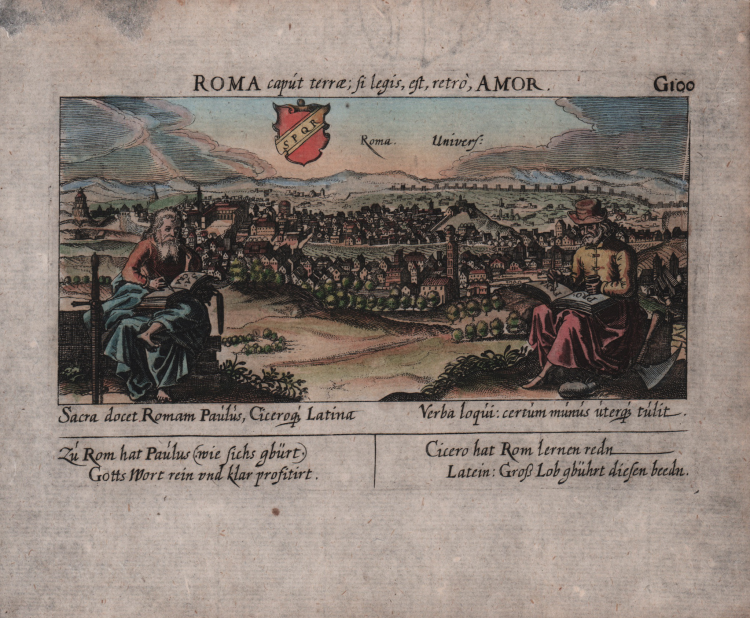



| Reference: | S48886 |
| Author | Daniel MEISNER |
| Year: | 1623 |
| Zone: | Rome |
| Printed: | Nurnberg |
| Measures: | 150 x 100 mm |


| Reference: | S48886 |
| Author | Daniel MEISNER |
| Year: | 1623 |
| Zone: | Rome |
| Printed: | Nurnberg |
| Measures: | 150 x 100 mm |
Panorama of the city, taken from the 1678 edition of the famous "Sciagraphia Cosmica" with the title "Das ist Newes Emblematisches Buechlei, dainen in acht Centurijs die vornembste Stat, Vestung, Schlosser der ganzen Welt...Nuremberg, 1678''.
"Of little topographical interest, the view shows the Capitoline Hill emerging from the adjacent urban fabric, while the view to the left closes in on a scarcely recognizable St. Peter's. The author's name is only written on the title page. In addition to Meisner himself, the engravers involved included Merian, Furck and Stimmer" (cf. Marigliani p. 194).
The Sciagraphia Cosmica was expanded under the supervision of Kieser after Meisner's death in 1625, resulting in a composition of 800 magnificent engravings.
Each engraving is characterised by a motto above the image and emblematic verses (in Latin or German). The work is a combination of two popular genres, the Book of Coats of Arms and the Book of City Plants.
Among the master engravers and illuminators who contributed to this series are Matthäus Merian, Sebastian Furck, Christian Stimmer and possibly Meisner himself, who conceived the work and contributed much of the prose.
Copper engraving, with margins, with fine hand coplour, in perfect condition.
|
Cremonini pagg. 57/58, 45a; C. Marigliani, "Le Piante di Roma delle collezioni private", tav. 97.
|
Daniel MEISNER (Attivo nella prima metà del XVII sec.)
|
The poet Daniel Meisner was born in what is now Chomutov in the Czech Republic (also known as Comothau or Komotau) but little is known about his life. Daniel Meisner first published his "Thesaurus Philo-politicus" in 1623 and is later known as the "Sciagraphia Cosmica" this series continued to be expanded under Kieser's supervision after Meisner's death in 1625, eventually comprising over 800 magnificient engravings.Each engraving is distinguished by a motto above the image and emblematic verses (usually in Latin and German) beneath. The work is a fascinating combination of two popular genres - the Emblem Book and the Book of Town Plans, e.g. Braun and Hogenberg. The allegorical imagery is often cryptic, even bizarre - but always fascinating:Among the master engravers and illustrators that contributed to this series, usually working from earlier sources, were Matthäus Merian, Sebastian Furck, Christian Stimmer and possibly Meisner himself, who conceived the work and contributed many of the verses.
|
|
Cremonini pagg. 57/58, 45a; C. Marigliani, "Le Piante di Roma delle collezioni private", tav. 97.
|
Daniel MEISNER (Attivo nella prima metà del XVII sec.)
|
The poet Daniel Meisner was born in what is now Chomutov in the Czech Republic (also known as Comothau or Komotau) but little is known about his life. Daniel Meisner first published his "Thesaurus Philo-politicus" in 1623 and is later known as the "Sciagraphia Cosmica" this series continued to be expanded under Kieser's supervision after Meisner's death in 1625, eventually comprising over 800 magnificient engravings.Each engraving is distinguished by a motto above the image and emblematic verses (usually in Latin and German) beneath. The work is a fascinating combination of two popular genres - the Emblem Book and the Book of Town Plans, e.g. Braun and Hogenberg. The allegorical imagery is often cryptic, even bizarre - but always fascinating:Among the master engravers and illustrators that contributed to this series, usually working from earlier sources, were Matthäus Merian, Sebastian Furck, Christian Stimmer and possibly Meisner himself, who conceived the work and contributed many of the verses.
|